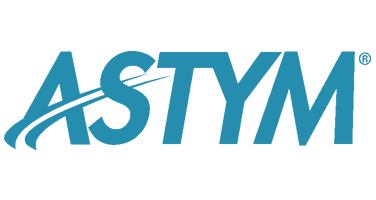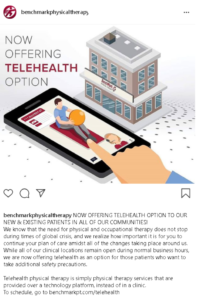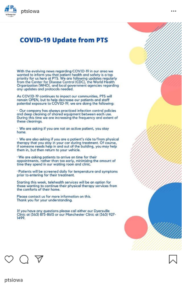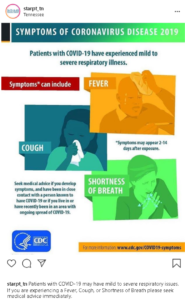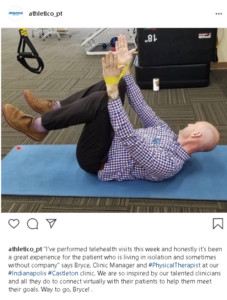
02 Apr 7 Examples of Patient Communication During a Crisis ( + Free Checklist)
With the current environment, we’re all facing new obstacles and challenges when it comes to private practice, rehab therapy, and business in general.
In this guide, we’ll cover how to address this crisis in your patient communications and how your practice can continue thriving.
What to say
Communicating to patients and prospects:
Your patients and future prospects want to see an open and transparent dialogue about your practice when it comes to this situation. What are you doing? How will you be responding? What actions have you taken or plan to take in the future?
We know there’s a lot on your plate. That’s why we’ve put together a quick checklist of things you should think about and communicate to your patients during this crisis: Download your free patient communication checklist.
While you may continue treating patients in your clinic, it’s no surprise that this virus may have caused a decline in returning and new patients. Many private practices and other rehab clinics have turned to telehealth as an alternative to continue patient care. If you do not have these resources at your fingertips, here’s what you can do:
- Communicate your available hours via social media and email.
- If able and appropriate, offer home care visits. (For updated guidelines, please visit CDC’s website.)
- Ensure safety and health protocols are continuously met at your clinic for open facilities.
- Give patients the option to schedule future visits when they’re comfortable visiting your clinic.
- Create a plan for cash-based business by offering specials or upfront coupons your patients can purchase for available services.
What to post
Social Media during a crisis:
Social media is seeing a huge increase in traffic due to the stay at home orders across the country. While it may sound like a good opportunity to start posting more, it’s important to think about what you’re posting and why you’re posting it.
Before creating a social media post, here are a few things you should be asking yourself: Is this relevant to my patients? How is this helpful?
Your patients may be experiencing some of the same emotions as you while facing this crisis: confusion and uncertainty. Keep this in mind when you’re writing a post for your social channels. We recommend taking part in a few of these social media strategies when creating posts for your audience.
Types of Posts
Social Media Strategies: Types of posts that are helpful and relevant to your patients
We’ve compiled a list of different types of posts from physical therapy clinics, private practices, and rehab therapy facilities across the country. Each post has a different goal and addresses how their clinic is responding to the situation.

Informational (Alternatives to Patient Care):
Benchmark Physical Therapy uses this post to explain their new telehealth option for patients by addressing what telehealth physical therapy is, what to expect, and how they’re continuing to put their patients first.

Inspirational:
This is one of many inspirational posts from Apex Physical Therapy. They’ve addressed how their clinic is approaching this epidemic through other social media posts. They also use their platform to encourage their audience to spread positivity through participating in different exercises like gratitude, stretching, breathing exercises, and more.

A Note from the “Owner(s)”:
This style of post lists out your response to the situation in the form of a note or a short letter. Physical Therapy Solutions uses its platform to inform their audience about the actions they are taking and asking patients to help take part in the solution by following guidelines and staying healthy.

Advice about the Virus:
As a healthcare professional, patients look to you for resources and information regarding health and wellness. Post up-to-date information from credible sources such as the World Health Organization (WHO), the Centers for Disease Control and Prevention (CDC), and the American Medical Association (AMA). Just as STAR Physical Therapy has done in this post, always cite your source. Citing your source increases your credibility and ensures your message is clear when patients share your post with others.

Cleaning Measures You’re Taking:
Your patients want to see how you’ll be keeping them safe by keeping your equipment clean! If you’re still treating patients in the clinic, ease their minds by communicating exactly what you’re doing to keep your facility clean. This post is to inform Astym providers on how to best clean their Astym instruments.

About Your Staff:
Athletico Physical Therapy shares an example of how their telehealth experiences are making an impact in their community. This post shows how their company is helping their patients in alternative ways. It also helps patients see how individual physical therapists are making a difference and are dedicated to their health during this difficult time.

Clinic Treatment Updates or Program Bundles:
If you have a cash-based business plan or are able to offer specials on a few of your care offerings or interventions, share them with your patients. Money is tight right now for a lot of people. You can continue helping them while offering additional benefits for your service. This post clarifies the telehealth opportunities available to patients and offers them a great deal for alternative ways to continue on their road to recovery. Back2Normal Physical Therapy explains the type of sessions available to patients and tells them exactly who to contact, how to get started, and what to expect.
What Can You Do Right Now?
Right now, your patients need you to communicate effectively more than ever. By staying in touch, posting on social media, and encouraging your audience, you can help patients feel cared for through this crisis.
The Astym program provides you with the right messaging, the right materials, and the right methods of engagement that elevates your practice, engages your patients, and attracts new referrals.
We’ve created the following checklist to help you develop a patient communications strategy during this epidemic: Download your free patient communication checklist.
While many of us are at home, Astym providers can continue improving their skills through online Advanced Application modules! These online modules go into specific patient populations like runners, tennis players, etc. and provide the clinical tips, educational materials, and treatment methods to more effectively treat their specific conditions and injuries. We’re always working on new modules so you never stop improving.
If you’re looking for helpful content to relay to your patients, visit the World Health Organization (WHO), the Centers for Disease Control and Prevention (CDC), or the American Medical Association (AMA) to stay up to date on the most recent announcements and guidelines.
Other Articles You Might Like:
